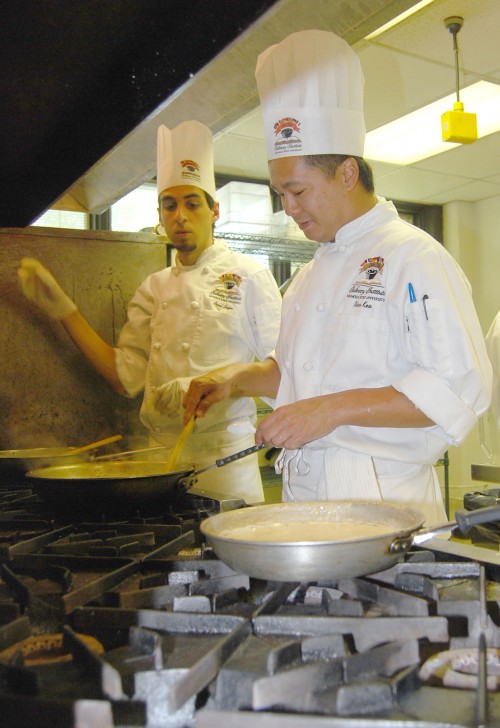
St. Mary CAA turns 45; announces new grant program
April 25, 2012
Naquin 8th Lafourche student named to BESE since 1997
April 25, 2012Nicholls State University’s John Folse Culinary Institute is changing the mantra from, “If you can’t take the heat, get out of the kitchen,” to “If there’s not enough space in the kitchen, build a new one.”
“They had 14 to 15 kids in the first classes when the program was started 1994, and it increased exponentially over the years with almost no recruiting,” said Randy Cheramie, executive director and instructor, who has been with the department since 1999. “In 2001, we had 60 students. Now, we have 305.”
The department is currently conducting classes at two different locations, one on campus and another at the Carmel Inn in Thibodaux, where the student-run restaurant Bistro is located. These two locations provide the department with a total of 9,000 square feet of teaching space.
According to university President Dr. Stephen T. Hulbert, in 2010, the Board of Supervisors of the University of Louisiana System approved the program’s move to the Rienzi Plantation but with current number of students, the building is too small to accommodate the department.
“Enrollment in the Nicholls culinary curriculum is expanding to the point that a far larger classroom facility is required than would be permitted at Rienzi,” Hulbert said in a press release. “To that end, a new on-campus culinary arts building, totaling 31,119 square feet, is in the works on an 8.1-acre site at La.1 and Bowie Road. I do look forward to talking more about this facility as it develops, but today I want the community to know that Nicholls will always be grateful to the J.B. Levert Land Company for having donated this beautiful home to the university.”
The property was given back to the company and has since been sold to private citizen who intends to to turn the plantation into a private home.
According to Cheramie – one of the culinary department’s 14 teachers – there was not enough room on the plantation’s property to expand the building without removing old oak trees or making massive renovations to the home.
“No one wanted to sell land around it, and we didn’t want to cut down the trees,” Cheramie said. “We would have been busting at the seams in there.”
Work on the new building, which will triple the department’s current square footage and provide teaching room for 600 students, is scheduled to be complete in the fall of 2013.
“I won’t know how to act with all that space,” Cheramie said, laughing. “It will be nice for us to all be under one roof.”
Cheramie is not the only one excited about the new building.
“I heard about the new building, and that it will be above and beyond everyone’s expectations,” said recent graduate Johnathan Lynch. “I am so excited to see the new building.”
Originally from Ruston, Lynch graduated from the university in the summer of 2011, and is currently employed in the Los Angeles restaurant industry.
“I have had so many great opportunities because of the university and the culinary department,” Lynch said. “I still talk to the culinary teachers there, and they do anything they can to help you.”
Lych credited the department’s accelerated growth to not only the teachers but to the department as a whole.
“With more graduates each year, people are seeing that it is small but serious facility, and that speaks for itself,” Lynch said. “The new building will be a great addition to the university.”
According to Lynch, he also sees the shift toward interest in the culinary world as another driving force in the expansion of the institute.
“People are getting excited about food, whether it’s from watching television or reading a book,” Lynch said. “Just from that excitement, I am not surprised at the rapid growth of the culinary department.”
Lynch said he plans to visit once the new building is complete, and he recalled the challenges the department faced in its current location.
“I tried to take the smaller classes with only eight to 10 students, so that there would be more space to work and more one-on-one time with the teachers,” he said.
The new building will feature four large teaching areas, dedicated kitchens, each about 1,200 to 1,400 square feet.
It will house a baking and pastry kitchen, a meat fabrication site, garde manger – a ventilated area where cold dishes are stored, and a soup, stock and sauce kitchen, which will double as a product development kitchen. “The other (kitchen) will be a skills kitchen where students will learn sautéing, steaming, poaching, roasting, pan frying, deep frying and grilling,” Cheramie said. “Lots of electives will be taught in that kitchen.”
The new building will also house a demo kitchen, dining room, coolers and freezers.
The new facility marks a huge leap from the culinary department’s humble start.
“Former NSU President Donald Ayo and John Folse cooked up the idea (of a culinary department) over a bottle of wine or two,” Cheramie said, laughing. “Louisiana is the Mecca of food. Foodies declare it the region with the most important cuisine in America. Food here is like jazz. Louisiana is melting pot of people, food, traditions and culture. It’s like a gumbo recipe.”
The department initially offered only associate degrees. Within the year, it had been approved for a 4-year degree plan.
“We have a jewel of culinary education here in the south central United States,” Cheramie said. “Our students are better equipped than some of the students from the more expensive culinary schools, and our low cost is what brings many of them here to learn.”
Over the years, students from Washington, Maine, California and even Japan, India and several South American countries have attended the institute. The department has awarded more than 230 bachelor’s degrees, more than 90 associate’s degrees. On average, it graduates 33 students per year.
“We just recently had five or six kids who aren’t even from Louisiana come in to tour the school as prospective students,” Cheramie said.
To Cheramie, being a chef doesn’t stop at cooking. There are some added ingredients the department strives to teach.
“We teach our cooks to be better managers of the bottom line and of people, to properly manage their workers,” Cheramie said. “The technique of cooking great food is very important. But you don’t just come here to cook. You come here for a career. This is an office, not just a kitchen. We want students to have the business part of being a cook down pat, down to a science.”
When it comes to the program’s popular courses, it’s pretty much a given.
“Anywhere they get to cook and eat, they are all about it,” Cheramie said. “To them, cooking and eating what they cook equals fun.”
And students not are the only ones flocking to the kitchens. “We have people on bus tours wanting to stop to view cooking demonstrations, and we don’t really have the space,” Cheramie said. “Once we are in the new building, these demos could be a source of revenue generation for the university.”
Who wouldn’t want to pick up a few tips from an award-winning culinary school?
Over the last eight years the school has competed in the American Cheese Society’s competitions, students have brought home seven bronze medals and one silver medal. For five years in a row, the department has also won regional events in the San Pellegrino Almost Famous cooking contest and sent contestants to the national event in Napa Valley, Calif..
“We don’t have a national title yet, but our kids are always in the top three or four at San Pellegrino,” Cheramie said.
He has even greater hopes for the department once it is in its new home.
“There is light at the end of the tunnel,” Cheramie said. “I am expecting even more students once the new building is completed. It will enhance recruiting in a big way.”
Paul Lupo, left, a culinary arts senior at Nicholls State and senior Rico Keo prepare beef carpaccio in one of the university’s three kitchens.









